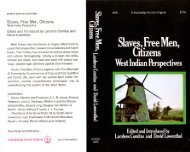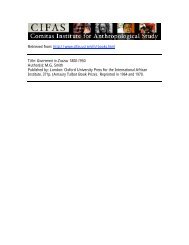You also want an ePaper? Increase the reach of your titles
YUMPU automatically turns print PDFs into web optimized ePapers that Google loves.
<strong>Kano</strong> <strong>Chronicle</strong> 45<br />
years.?? This tends to support the view that the original <strong>Chronicle</strong> was com- /<br />
piled in .the mid-sixteenth century from various documents and oral sources /'<br />
having special knowledge of the chiefdom's history. Thereafter, on my<br />
reading in relation to other histories and king lists of <strong>Kano</strong>, the <strong>Chronicle</strong><br />
was periodically updated at irregular intervals of between fifty and a hWldred<br />
or more years, sufficient to ensure comparable degrees of inaccuracy,<br />
incompleteness and uu'reliability in the earlier reigns of each new section,<br />
from Yaji's time onwards.<br />
VI<br />
Murray Last correctly identifies a number of anachronisms and hesitations in<br />
the <strong>Chronicle</strong> '5 account of developments at <strong>Kano</strong> before 1450 A.D., attributing<br />
these to 17th century writers. Some are rather superficial, for example<br />
reference to guns (bindiga) in Dauda's reign (1421-1427 A.D.).? 8 Likewise,<br />
, '~In the days of Yaji, it is said, Sa"rkin Debbi, Sarkin Daba and Sarkin Gano<br />
brought horses to <strong>Kano</strong>, but this story is not worthy of credence.,,7 9 Nonetheless<br />
its account of the siege and seizure of Santolo makes frequent re-<br />
,ference to horses. Though clearly such titles as Madawaki and Dawaki<br />
(i.e. commanders of calvary) in the reign of Warisi, Bagauda's son (1063<br />
1095 A.D.) .are anachronistic, so too are the titles of Galadima, Barawa,<br />
Magayaki, Makama, Jarumai, Barde in that reign.80 Such titular anachronisms<br />
provide no firm basis for the conclusion that horses were not known in<br />
Kana. The Bayajidda legend tells of his coming to Daura on a horse and seeking<br />
to water his horse before killing the dreaded snake. 8 1 In the passage just<br />
cited, the chiefs of Debbi,· Dab and Gano, who according to the <strong>Chronicle</strong><br />
arrived in <strong>Kano</strong> COWltry nine 'years before Bagauda,82 are said to have<br />
brought horses during Yaji's reign, perhaps from Borno. There are other<br />
questionable attributions, such as Gijimasu's wall-building and slaughter of<br />
a hundred cattle on the first day.8 3<br />
'<br />
Murray Last performs a valuable service in drawing attention to the many<br />
anachronisms, uncertainties and errors in the <strong>Kano</strong> <strong>Chronicle</strong>, and especially<br />
for the first 400 years of its record, which suggests that the document was<br />
originally drafted in the 16th century. He also identifies various omissions or<br />
failures in the record; but such omissions are not confined to the. earlier<br />
centuries, they apply equally well to the last two hWldred years of Hausa<br />
rule at Kana. Altogether his analysis of the historicity of the <strong>Chronicle</strong> for<br />
the period of Hausa rule at <strong>Kano</strong> is a contribution of permanent value to<br />
historical studies of this region, however, the lifIlitations of this critique,<br />
which are sometimes expressed but more often assumed by its author,<br />
should not be ignored. What Murray Last argues is that the current version<br />
of the <strong>Chronicle</strong>, whether in Arabic, English or Ha~sa, basically dates from





